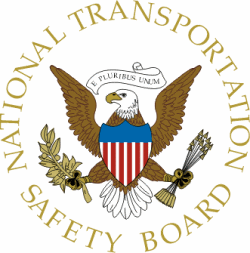Tue, Jan 12, 2010
Five Reportable Incidents Added To Notification
Requirements
 The NTSB is amending its regulations concerning notification
and reporting requirements regarding aircraft accidents or
incidents. In particular, the NTSB is adding regulations to require
operators to report certain incidents to the NTSB. The NTSB is also
amending existing regulations to provide clarity and ensure that
the appropriate means for notifying the NTSB of a reportable
incident is listed correctly in the regulation.
The NTSB is amending its regulations concerning notification
and reporting requirements regarding aircraft accidents or
incidents. In particular, the NTSB is adding regulations to require
operators to report certain incidents to the NTSB. The NTSB is also
amending existing regulations to provide clarity and ensure that
the appropriate means for notifying the NTSB of a reportable
incident is listed correctly in the regulation.
On October 7, 2008, the NTSB published an NPRM titled
"Notification and Reporting of Aircraft Accidents or Incidents and
Overdue Aircraft, and preservation of Aircraft Wreckage, Mail,
Cargo, and Records" in the Federal Register. This NPRM proposed,
and the final rule codifies the addition of five reportable
incidents, the reporting of which the NTSB believes will improve
aviation safety.
The operator of any civil aircraft, or any public aircraft not
operated by the Armed Forces or an intelligence agency of the
United States, or any foreign aircraft shall immediately, and by
the most expeditious means available, notify the nearest National
Transportation Safety Board (NTSB) office when an aircraft accident
or any of the following listed serious incidents occur:
-
 Failure of any internal turbine engine component that results
in the escape of debris other than out the exhaust path.
Failure of any internal turbine engine component that results
in the escape of debris other than out the exhaust path.
- In-flight fire.
- Aircraft collision in flight.
- Release of all or a portion of a propeller blade from an
aircraft, excluding release caused solely by ground contact.
- A complete loss of information, excluding flickering, from more
than 50 percent of an aircraft's cockpit displays known as
Electronic Flight Instrument System (EFIS) displays, Engine
Indication and Crew Alerting system (EICAS) displays, Electronic
Centralized Aircraft Monitor (ECAM) displays, or other displays of
this type, which generally include a primary flight display (PFD),
primary navigation display (PND), and other integrated
displays.
- Airborne Collision and Avoidance System (ACAS) resolution
advisories issued either when an aircraft is being operated on an
instrument flight rules flight plan and compliance with the
advisory is necessary to avert a substantial risk of collision
between two or more aircraft, or to an aircraft operating in class
A airspace.
- Damage to helicopter tail or main rotor blades, including
ground damage, that requires major repair or replacement of the
blade(s).
- Any event in which an aircraft operated by an air carrier lands
or departs on a taxiway, incorrect runway, or other area not
designed as a runway, or experiences a runway incursion that
requires the operator or the crew of another aircraft or vehicle to
take immediate corrective
- action to avoid a collision.
The final rule was published in the Federal Register January
7th, and the revisions and additions published in this final rule
become effective March 8, 2010.
More News
Airplane Bounced About 3 Ft Then Touched Back Down And Then, With No Brakes Applied, The Airplane Began Veering To The Left Analysis: The pilot entered the airport traffic pattern >[...]
Aero Linx: British Microlight Aircraft Association (BMAA) The primary focus within all aviation activity is SAFETY. In all aspects of our sport SAFETY must come first, whether it b>[...]
From SnF25 (YouTube Edition): William Wynne Builds Practical Aircraft Engines on the Corvair Platform Seeking an affordable alternative to the traditional aircraft engine options, >[...]
How To Get A Story On Aero-TV News/Feature Programming How do I submit a story idea or lead to Aero-TV? If you would like to submit a story idea or lead, please contact Jim Campbel>[...]
From 2023 (YouTube Edition): Bridge of CiES CiES Inc. is a Bend, Oregon-based designer and manufacturer of modular embedded aircraft systems and sensors. The company’s fuel-l>[...]
 NTSB Final Report: Aviat A1
NTSB Final Report: Aviat A1 ANN's Daily Aero-Linx (07.08.25)
ANN's Daily Aero-Linx (07.08.25) Classic Aero-TV: Fly Corvairs Reliable Engine Alternative
Classic Aero-TV: Fly Corvairs Reliable Engine Alternative ANN FAQ: Contributing To Aero-TV
ANN FAQ: Contributing To Aero-TV Classic Aero-TV: CiES Fuel-Quantity and e-Throttle Systems Praised
Classic Aero-TV: CiES Fuel-Quantity and e-Throttle Systems Praised




